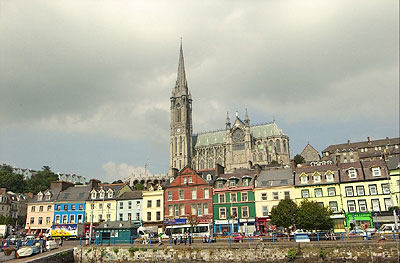Cobh, the Queenstown Story:
Cobh is a town of three names (Cobh, Cove and Queenstown) and millions of memories.
Many books and novels have been written about the Great Famine in Ireland in the 1800’s, the mass exodus of people in search of a better life elsewhere, and the pain and suffering during their journey.
Cobh was at the centre of this mass migration, was an important port of call for ocean liners up to 1950 and is linked to the sinking of two luxury ocean liners.
Cobh’s Queenstown Story
- In 1801, a convict ship left from Cobh for Australia.
- Betwen 1845 and 1950, of the 6.5 million people who emigrated from Ireland in search for a better life, over 2.5 million of these left from Cobh, making Cobh the single most important port of emigration.
- Cobh harbour was one of the largest and safest habours in the past, and was capable of taking the largest vessels afloat. The great Trans-atlantic liners used to come here up to the 1950s. The Titanic was one such luxury liner to call here and Cobh was her last port of call on its maiden voyage. It was billed as ‘the safest liner in the world’ before its doomed Atlantic crossing in 1912.
- Another unfortunate and shocking association with luxury liners is the sinking of the Lusitania in 1915. This Cunard Line luxury ocean liner was sunk off Kinsale by a German submarine, an action which triggered the involvement of America in the Great War. The survivors were brought back to Cobh and some of the dead are buried in the Old Church Cemetery.
At the Cobh Heritage Centre, the Queenstown Story tells of Cobh’s maritime history, including the emigration from Cobh in the period of the famine in 1845 up to the era of the great liners in the 1950s. The historical role which Cobh harbour played as a port is also documented. Statues of Annie Moore and her two brothers stand outside the Centre. Annie Moore was the first emigrant to be processed on Ellis Island in 1892.
Why was Cobh referred to as Queenstown? After a visit by Queen Victoria in 1849, Cobh was renamed Queenstown in honour of her visit. In 1921, the town councillors decided to revert the name to Cobh, being Irish for Cove.
Cobh is a quieter place these days and is a pleasant town with a pretty port area. Its main landmark, St. Coleman’s Cathedral with its 47 bell carillon, dominates its skyline from the top of the hill.
On the quayside there is a memorial to the victims of the Lusitania. The port administration office is the brightest yellow building in town. At the Titanic Bar, you can have a drink without fear of sinking.
Cobh is situated on Great Island, one of the three large islands in Cork harbour, Little Island and Fota are the others. The three islands are now all joined by roads and bridges.
Travel Signposts Cobh Photo Gallery
Co. Cork, Ireland


 Take Better Digital Photos eBook
Take Better Digital Photos eBook Guerrilla Travel Photography eBook
Guerrilla Travel Photography eBook
Leave a Reply